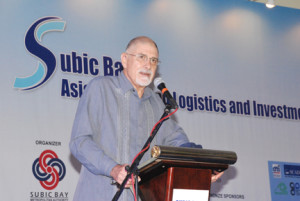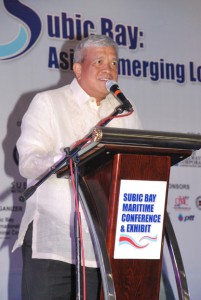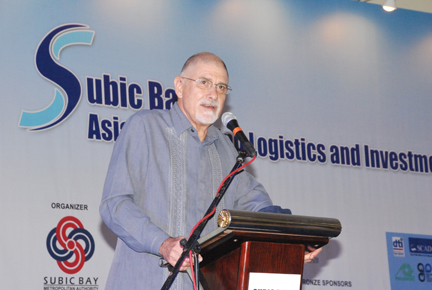The Philippine government should put a cap on capacity of and volume passing through Manila ports in order to drive shipments to alternate ports such as Subic Bay and Batangas, according to the senior adviser of the American Chamber of Commerce of the Philippines.
Subic Bay is 110 kilometers north of Manila, and Batangas, also about 110 kilometers but south of Manila.

Speaking before more than 500 port and shipping executives and other logistics stakeholders at last week’s Subic Bay Maritime Conference and Exhibit, John Forbes said the Philippine government should take a hint from Thailand which, in 1998, capped to 1 million twenty-foot equivalent units (TEUs) shipments that could pass through the Port of Bangkok. This, he pointed out, led to the more active use of the Port of Laem Chabang, now Thailand’s biggest port.
By 2010, Port of Laem Chabang’s volume was 7 million TEUs from only 500,000 TEUs in 1997. In comparison, the Port of Bangkok had a steady throughput — 1.5 million TEUs in 2010 from 1.47 million TEUs in 1997.
Forbes also pointed to the Vietnam model. The Saigon new port was identified in 2005 as a possible area to relocate inner city ports. Relocation began in 2009 and the port has since witnessed a 12.6% annual growth. In 2010 it handled 2.5 million TEUs.
In contrast, the cluster of port terminals, including the old Saigon port and Vietnam International Container Terminals, located in the Central business district, is witnessing declining container throughput. In 2010, it saw 4.2 million TEUs.
“We need to decongest the old port by building new port capacity away from urban centers,” Forbes told delegates to the conference organized by Subic Bay Metropolitan Authority and co-organized by Subic Bay International Terminal Corp.
“Adding existing capacity in Manila should not be an option,” he said, adding the recently opened Berth 6 should be the last.
Careful study

Philippine Chamber of Commerce and Industry (PCCI) vice president for Transport and Logistics Angelito Colona said Forbes’ proposal needs to be carefully looked at.
“We should study it carefully as it might have some negative effects on us,” Colona said at one of the conference’s question-and-answer segments.
“As vice president of PCCI Transport sector, I will personally see to it how we could be of support to the initiative (of boosting Subic traffic),” Colona added.
Last year, the government’s economic managers recommended the issuance of an order to divert a certain percentage of cargo from Manila to Batangas and Subic Bay.
The previous SBMA administration also requested government to stop further development of Manila ports to give Subic Bay as well as Batangas a fighting chance.
Government has so far remained indifferent to the recommendations.
More suggestions
In his presentation, Forbes also put forward recommendations of Arangkada (loosely translated, Fast Forward) Philippines that would lure more investors and port stakeholders to Subic Bay. Arangkada Philippines, in which Forbes is one of the main proponents, is a comprehensive advocacy paper intended to share recommendations leading to the creation of new foreign investment and jobs within this decade.
The paper proposed that Subic port be developed into a truly free port for the distribution for goods from the United States and Europe to Asia. As such, cargoes should be allowed to freely enter uncontrolled assigned “to order” of bearer as long as the goods do not leave the area.
Customs, the paper added, should be outside the Subic freeport to a perimeter defined by the SBMA and tight safeguards against smuggling should be put in place before allowing goods to enter the freeport uncontrolled.
Another recommendation is the creation of a National Capital Region/Central Luzon Transportation Master Plan that would detail strategies for the long-term use of international seaports of Manila, Subic and Batangas. This strategy involves capping the capacity of ports in Manila; giving shipping lines incentives to use Subic and Batangas; and ensuring future expansion should only be in Batangas and Subic.
Arangkada Philippines’ final recommendation is to build the manufacturing and agri-business export potential of Central Luzon to attract firms relocating from China and Japan.





